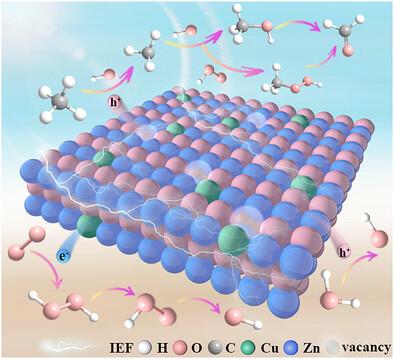Intensifying Internal Electric Field on ZnO Nanoplates with Polar Surface Exposure and Cu Doping for Efficient Photocatalytic Methane Oxidation to Oxygenates
IF 19
1区 材料科学
Q1 CHEMISTRY, MULTIDISCIPLINARY
引用次数: 0
Abstract
Semiconductor photocatalysis has rendered a potential route for aerobic methane (CH4) conversion to valued-added oxygenates under mild conditions, whereas suffering from low reaction efficiency caused by the high inertness of CH4 molecules and the fast recombination of photogenerated charge carriers. Herein, Cu doped ZnO nanoplates with polar surface exposure are employed as an efficient photocatalyst for CH4 oxidation in the presence of O2, which exhibit the liquid C1 oxygenates yield of 4742.2 µmol g−1 h−1 with a selectivity of 99.6%, outperforming the counterparts with nonpolar surface exposure or without Cu doping. The detailed investigation elucidates that the activity enhancement is largely contributed by the intensified internal electric field, improving the separation of charge carriers and thus supplying sufficient electrons to drive surface redox reactions. More active/adsorption sites are also favorable to be created on Cu doped polar surface of ZnO, facilitating CH4 conversion. Besides, the generation of ·OH radicals is proposed to follow a pathway of O2 → ·OOH → H2O2 →·OH, wherein the doped Cu plays a significant role for O2 reduction and H2O2 dissociation to ·OH, thereby enabling efficient CH4 activation. This work offers new strategies for designing efficient photocatalysts to boost CH4 oxidation under mild conditions.

在ZnO纳米板上强化内部电场,并在极表面曝光和Cu掺杂下进行高效光催化甲烷氧化制氧合物
半导体光催化是在温和条件下将好氧甲烷(CH4)转化为增值氧化合物的潜在途径,但由于CH4分子的高惰性和光生成的载流子的快速重组导致反应效率低。本研究将Cu掺杂ZnO纳米片作为O2存在下CH4氧化的高效光催化剂,其液态C1氧化物的产率为4742.2µmol g−1 h−1,选择性为99.6%,优于非极性表面暴露或未掺杂Cu的对应物。详细的研究表明,活性的增强主要是由于内部电场的增强,从而改善了载流子的分离,从而提供了足够的电子来驱动表面氧化还原反应。Cu掺杂ZnO的极性表面也有利于形成更多的活性/吸附位点,有利于CH4的转化。此外,提出了·OH自由基的生成遵循O2→·OOH→H2O2→·OH的途径,其中掺杂Cu对O2还原和H2O2解离成·OH起着重要作用,从而实现了高效的CH4活化。这项工作为设计在温和条件下促进CH4氧化的高效光催化剂提供了新的策略。
本文章由计算机程序翻译,如有差异,请以英文原文为准。
求助全文
约1分钟内获得全文
求助全文
来源期刊

Advanced Functional Materials
工程技术-材料科学:综合
CiteScore
29.50
自引率
4.20%
发文量
2086
审稿时长
2.1 months
期刊介绍:
Firmly established as a top-tier materials science journal, Advanced Functional Materials reports breakthrough research in all aspects of materials science, including nanotechnology, chemistry, physics, and biology every week.
Advanced Functional Materials is known for its rapid and fair peer review, quality content, and high impact, making it the first choice of the international materials science community.
 求助内容:
求助内容: 应助结果提醒方式:
应助结果提醒方式:


